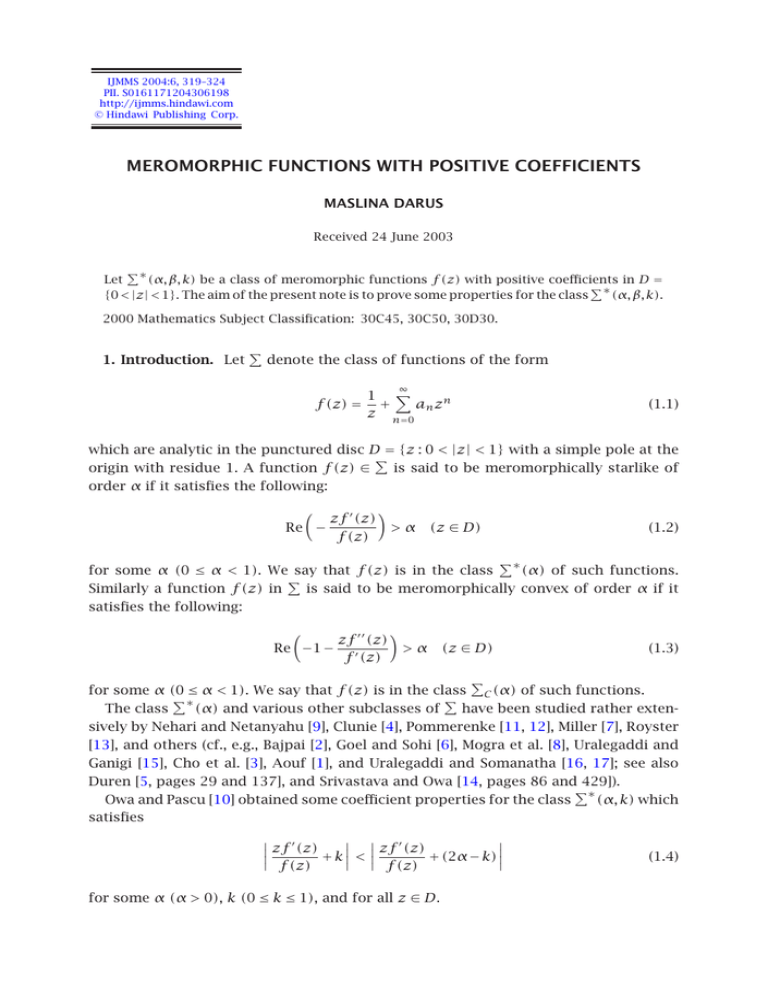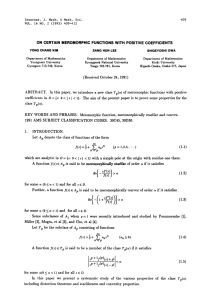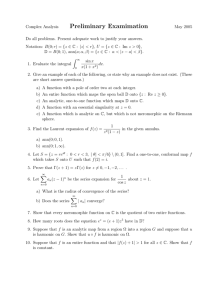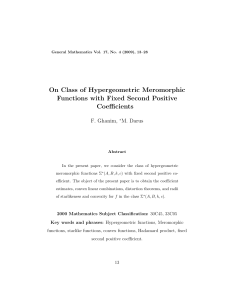MEROMORPHIC FUNCTIONS WITH POSITIVE COEFFICIENTS
advertisement

IJMMS 2004:6, 319–324
PII. S0161171204306198
http://ijmms.hindawi.com
© Hindawi Publishing Corp.
MEROMORPHIC FUNCTIONS WITH POSITIVE COEFFICIENTS
MASLINA DARUS
Received 24 June 2003
Let ∗ (α, β, k) be a class of meromorphic functions f (z) with positive coefficients in D =
{0 < |z| < 1}. The aim of the present note is to prove some properties for the class ∗ (α, β, k).
2000 Mathematics Subject Classification: 30C45, 30C50, 30D30.
1. Introduction. Let
denote the class of functions of the form
f (z) =
∞
1 +
an zn
z n=0
(1.1)
which are analytic in the punctured disc D = {z : 0 < |z| < 1} with a simple pole at the
origin with residue 1. A function f (z) ∈
is said to be meromorphically starlike of
order α if it satisfies the following:
zf (z)
Re −
>α
f (z)
(z ∈ D)
(1.2)
∗
(α) of such functions.
for some α (0 ≤ α < 1). We say that f (z) is in the class
Similarly a function f (z) in
is said to be meromorphically convex of order α if it
satisfies the following:
zf (z)
>α
Re −1 − f (z)
(z ∈ D)
(1.3)
for some α (0 ≤ α < 1). We say that f (z) is in the class C (α) of such functions.
∗
(α) and various other subclasses of
have been studied rather extenThe class
sively by Nehari and Netanyahu [9], Clunie [4], Pommerenke [11, 12], Miller [7], Royster
[13], and others (cf., e.g., Bajpai [2], Goel and Sohi [6], Mogra et al. [8], Uralegaddi and
Ganigi [15], Cho et al. [3], Aouf [1], and Uralegaddi and Somanatha [16, 17]; see also
Duren [5, pages 29 and 137], and Srivastava and Owa [14, pages 86 and 429]).
∗
(α, k) which
Owa and Pascu [10] obtained some coefficient properties for the class
satisfies
zf (z)
zf (z)
f (z) + k < f (z) + (2α − k)
for some α (α > 0), k (0 ≤ k ≤ 1), and for all z ∈ D.
(1.4)
320
MASLINA DARUS
In this note, the above definition is extended and we obtain the extended coefficient
inequalities.
The extended class of functions is defined as follows.
∗
(α, β, k)
Definition 1.1. A function f (z) ∈ is said to be a member of the class
if it satisfies
1
zf (z) + k < zf (z) + (2α − k)
β f (z)
f (z)
(1.5)
for some α (α > 0), β (0 < β ≤ 1), k (0 ≤ k ≤ 1), and for all z ∈ D.
2. Coefficient inequalities for functions. For the class
showed the following theorem.
∗
(α, k), Owa and Pascu [10]
Theorem 2.1. Let the function f (z) be defined by (1.1). If
∞
n + k + |2α + n − k| an r n+1 ≤ 2(1 − α)
(2.1)
n=2
∗
for some k (0 ≤ k ≤ 1) and α (0 ≤ α < 1), then f (z) ∈
(α, k).
∗
(α, β, k) is given as the following theorem.
Our first result for functions f (z) ∈
Theorem 2.2. Let the function f (z) be defined by (1.1). If
∞
n + k + β|2α + n − k| an r n+1 ≤ β(k + 1 − 2α) + 1 − k
(2.2)
n=2
for some k (0 ≤ k ≤ 1), α (0 ≤ α < 1), and β (0 < β ≤ 1), then f (z) ∈
∗
(α, β, k).
∗
Proof. Using the same technique as in [10], we know that for f ∈
(α, β, k),
zf (z) + kf (z) − βzf (z) + (2α − k)f (z)
∞
∞
1 1 (n + k)an zn − β(2α − k − 1) +
(2α + n − k)an zn .
= (k − 1) +
z n=0
z n=0
(2.3)
Therefore, applying the condition of the theorem, we have
r zf (z) + kf (z) − r βzf (z) + (2α − k)f (z)
≤ (k − 1) +
∞
+
∞
1
(n + k)an r n+1 − β(k + 1 − 2α)
r
n=0
β|2α + n − k|an r n+1
n=0
= k − 1 − β(k + 1 − 2α) +
∞
(n + k) + β|2α + n − k| an r n+1
n=0
≤ 0,
(2.4)
321
MEROMORPHIC FUNCTIONS WITH POSITIVE COEFFICIENTS
which shows that
∞
(n + k) + β|2α + n − k| an r n+1 ≤ β(k + 1 − 2α) + 1 − k.
(2.5)
n=0
It follows from the above that
1
zf (z)/f (z) + k
≤ 1.
β zf (z)/f (z) + (2α − k) (2.6)
The function f (z) given by
fn (z) =
β(k + 1 − 2α) + 1 − k zn
1
+ a0 +
z
(n + k) + β|2α + n − k|
(n ≥ 1)
(2.7)
∗
belongs to the class
(α, β, k).
This completes the proof of the theorem.
Corollary 2.3. Let the function f (z) be defined by (1.1) and let f (z) ∈
∗
(α, β, k), then
an ≤
β(k + 1 − 2α) + 1 − k
,
(n + k) + β|2α + n − k|
n ≥ 0.
. If f ∈
(2.8)
The result is sharp for functions fn (z) given by (2.7).
∗
(α, β, k) with a0 = 0, then Corollary 2.3 is true for some β
Remark 2.4. If f ∈
(0 < β ≤ (k − 1)/(k + 1 − 2α) ≤ 1) and α (0 ≤ α ≤ (k + 1)/2 < 1).
If β = 1, we get the following corollary.
Corollary 2.5 (see [10]). Let the function f (z) be defined by (1.1) and let f (z) ∈
∗
If f ∈
(α, 1, k), then
an ≤
1−α
,
n+α
n ≥ 0,
.
(2.9)
for some α (1/2 ≤ α < 1).
∗
3. Distortion theorem. A distortion property for functions in the class
(α, β, k)
is given as follows.
∗
(α, β, k), then
Theorem 3.1. If the function f (z) defined by (1.1) is in the class
for 0 < |z| = r < 1,
β(k + 1 − 2α) + 1 − k r
1
− a0 −
r
(1 + k) + β|2α + 1 − k|
1
β(k + 1 − 2α) + 1 − k r
,
≤ f (z) ≤ + a0 +
r
(1 + k) + β|2α + 1 − k|
(3.1)
322
MASLINA DARUS
with equality for
1
β(k + 1 − 2α) + 1 − k z
+ a0 +
(z = ir , r ),
z
(1 + k) + β|2α + 1 − k|
β(k + 1 − 2α) + 1 − k
1
− a0 −
r2
(1 + k) + β|2α + 1 − k|
1
β(k + 1 − 2α) + 1 − k
,
≤ f (z) ≤ 2 + a0 +
r
(1 + k) + β|2α + 1 − k|
f1 (z) =
(3.2)
with equality for
f1 (z) =
Proof. Since f ∈
1
β(k + 1 − 2α) + 1 − k z
+ a0 +
z
(1 + k) + β|2α + 1 − k|
∗
(z = ±ir , ±r ).
(3.3)
(α, β, k), Theorem 2.2 yields the inequality
∞
an ≤
n=0
β(k + 1 − 2α) + 1 − k
,
(1 + k) + β|2α + 1 − k|
n ≥ 0.
(3.4)
Thus, for 0 < |z| = r < 1, and making use of (3.4), we have
∞
∞
1
f (z) ≤ 1 + a0 +
an |z|n ≤ + a0 + r
an
z
r
n=1
n=1
1
β(k + 1 − 2α) + 1 − k r
≤ + a0 +
,
r
(1 + k) + β|2α + 1 − k|
∞
∞
1
f (z) ≥ 1 − a0 −
an |z|n ≥ − a0 − r
an
z
r
n=1
n=1
1
β(k + 1 − 2α) + 1 − k r
≥ − a0 −
.
r
(1 + k) + β|2α + 1 − k|
(3.5)
Also from Theorem 2.1 it follows that
∞
n=1
nan ≤ a0 +
β(k + 1 − 2α) + 1 − k
.
(1 + k) + β|2α + 1 − k|
(3.6)
Thus
∞
∞
1
n−1
f (z) ≤ 1 + a0 +
na
|z|
≤
+
a
+
nan
n
0
|z|2
r2
n=1
n=1
β(k + 1 − 2α) + 1 − k
1
,
≤ 2 + a0 +
r
(1 + k) + β|2α + 1 − k|
∞
∞
1
n−1
f (z) ≥ 1 − a0 −
na
|z|
≥
−
a
−
nan
n
0
|z|2
r2
n=1
n=1
β(k + 1 − 2α) + 1 − k
1
.
≥ 2 − a0 −
r
(1 + k) + β|2α + 1 − k|
Hence we complete the proof of Theorem 3.1.
(3.7)
MEROMORPHIC FUNCTIONS WITH POSITIVE COEFFICIENTS
323
4. Radii of starlikeness and convexity. The radii of starlikeness and convexity for
∗
(α, β, k) are given by the following theorem.
the class
∗
(α, β, k), then
Theorem 4.1. If the function f (z) defined by (1.1) is in the class
f (z) is meromorphically starlike of order ρ (0 ≤ ρ < 1) in the disk |z| < r1 (α, β, ρ),
where r1 (α, β, ρ) is the largest value for which
r1 = r1 (α, β, ρ) = inf
n≥0
1/(n+1)
(1 − ρ) (n + k) + β|2α + n − k|
.
(n + 2 − ρ) β(k + 1 − 2α) + 1 − k
(4.1)
The result is sharp for functions fn (z) given by (2.7).
Proof. It suffices to show that
zf (z)
f (z) + 1 ≤ 1 − ρ
(4.2)
for |z| ≤ r1 . We have
n+1
∞
n |z|
zf (z)
n=0 (n + 1) a
f (z) + 1 ≤ 1 − ∞ an |z|n+1 ≤ 1 − ρ.
n=0
(4.3)
Hence (4.3) holds true if
∞
∞
n+1
an |z|
(n + 1)an |z|n+1 ≤ (1 − ρ) 1 −
n=0
(4.4)
n=0
or
∞
(n + 2 − ρ)
an |z|n+1 ≤ 1;
1−ρ
n=0
(4.5)
with the aid of (2.8), (4.5) is true if
(n + k) + β|2α + n − k|
(n + 2 − ρ)
|z|n+1 ≤
.
1−ρ
β(k + 1 − 2α) + 1 − k
(4.6)
Solving (4.6) for |z|, we obtain
|z| ≤
1/(n+1)
(1 − ρ) (n + k) + β|2α + n − k|
(n + 2 − ρ) β(k + 1 − 2α) + 1 − k
(n ≥ 0).
(4.7)
This completes the proof of Theorem 4.1.
∗
Theorem 4.2. If the function f (z) defined by (1.1) is in the class
(α, β, k), then
f (z) is meromorphically convex of order ρ (0 ≤ ρ < 1) in the disk |z| < r2 (α, β, ρ), where
r2 (α, β, ρ) is the largest value for which
r2 = r2 (α, β, ρ) = inf
n≥0
1/(n+1)
(1 − ρ) (n + k) + β|2α + n − k|
.
n(n + 2 − ρ) β(k + 1 − 2α) + 1 − k
The result is sharp for functions fn (z) given by (2.7).
(4.8)
324
MASLINA DARUS
Proof. We omit the details of the proof as they are very tedious. It suffices to show
that
zf (z)
(4.9)
f (z) + 2 ≤ 1 − ρ
for |z| ≤ r2 , with the aid of Theorem 2.2. Thus we have the assertion of Theorem 4.2.
Acknowledgments. The work presented here was supported by the Intensified Research for Priority Areas (IRPA) Grant 09-02-02-0080-EA208. The author would like to
thank all the referees for their suggestions regarding the content of this note.
References
[1]
[2]
[3]
[4]
[5]
[6]
[7]
[8]
[9]
[10]
[11]
[12]
[13]
[14]
[15]
[16]
[17]
M. K. Aouf, On a certain class of meromorphic univalent functions with positive coefficients,
Rend. Mat. Appl. (7) 11 (1991), no. 2, 209–219.
S. K. Bajpai, A note on a class of meromorphic univalent functions, Rev. Roumaine Math.
Pures Appl. 22 (1977), no. 3, 295–297.
N. E. Cho, S. H. Lee, and S. Owa, A class of meromorphic univalent functions with positive
coefficients, Kobe J. Math. 4 (1987), no. 1, 43–50.
J. Clunie, On meromorphic schlicht functions, J. London Math. Soc. 34 (1959), 215–216.
P. L. Duren, Univalent Functions, Grundlehren der mathematischen Wissenschaften, vol.
259, Springer-Verlag, New York, 1983.
R. M. Goel and N. S. Sohi, On a class of meromorphic functions, Glas. Mat. Ser. III 17(37)
(1982), no. 1, 19–28.
J. Miller, Convex meromorphic mappings and related functions, Proc. Amer. Math. Soc. 25
(1970), 220–228.
M. L. Mogra, T. R. Reddy, and O. P. Juneja, Meromorphic univalent functions with positive
coefficients, Bull. Austral. Math. Soc. 32 (1985), no. 2, 161–176.
Z. Nehari and E. Netanyahu, On the coefficients of meromorphic schlicht functions, Proc.
Amer. Math. Soc. 8 (1957), 15–23.
S. Owa and N. N. Pascu, Coefficient inequalities for certain classes of meromorphically starlike and meromorphically convex functions, JIPAM. J. Inequal. Pure Appl. Math. 4
(2003), no. 1, Article 17, 1–6.
Ch. Pommerenke, Über einige Klassen meromorpher schlichter Funktionen, Math. Z. 78
(1962), 263–284 (German).
, On meromorphic starlike functions, Pacific J. Math. 13 (1963), 221–235.
W. C. Royster, Meromorphic starlike multivalent functions, Trans. Amer. Math. Soc. 107
(1963), 300–308.
H. M. Srivastava and S. Owa (eds.), Current Topics in Analytic Function Theory, World Scientific Publishing, New Jersey, 1992.
B. A. Uralegaddi and M. D. Ganigi, A certain class of meromorphically starlike functions
with positive coefficients, Pure Appl. Math. Sci. 26 (1987), no. 1-2, 75–81.
B. A. Uralegaddi and C. Somanatha, Certain differential operators for meromorphic functions, Houston J. Math. 17 (1991), no. 2, 279–284.
, New criteria for meromorphic starlike univalent functions, Bull. Austral. Math. Soc.
43 (1991), no. 1, 137–140.
Maslina Darus: School of Mathematical Sciences, Faculty of Sciences and Technology, University
of Kebangsaan Malaysia, Bangi 43600, Selangor, Malaysia
E-mail address: maslina@pkrisc.cc.ukm.my
![Mathematics 414 2003–04 Exercises 5 [Due Monday February 16th, 2004.]](http://s2.studylib.net/store/data/010415766_1-b65af2bb66ab8e422354912dcedcb6a6-300x300.png)










